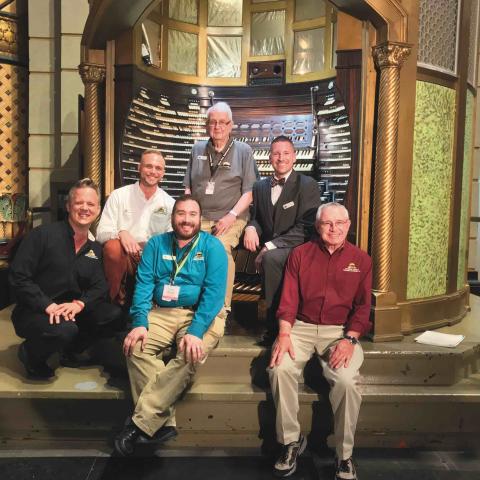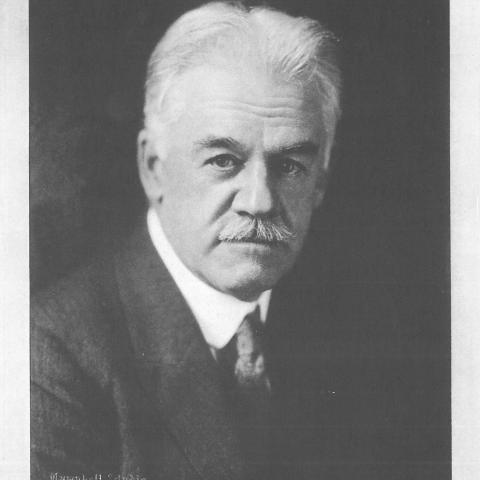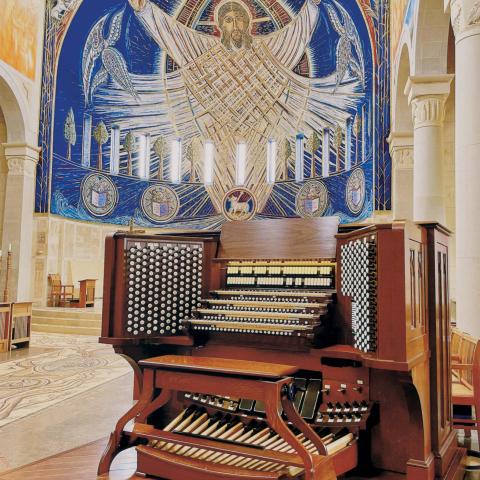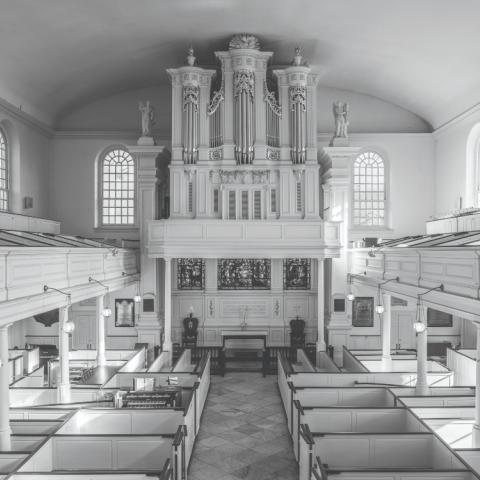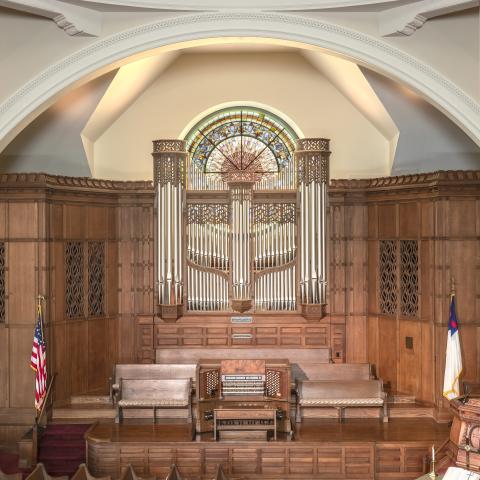Emery Brothers, Allentown, Pennsylvania; Stoneleigh, Villanova, Pennsylvania

Emery Brothers,
Allentown, Pennsylvania
Stoneleigh,
Villanova, Pennsylvania
In the Fall of 2017, the Organ Historical Society moved into its new headquarters, Stoneleigh, in Villanova, Pennsylvania, the former home of the John and Chara Haas family. At the time, an Aeolian-Skinner residence organ became available and plans were made to install it in the former living room of Stoneleigh. The organ dates from a crucial period in American organbuilding when, following the Great Depression, organ business declined more than sixty percent, and it was imperative for two of the country’s prestigious organ companies, Aeolian and Skinner, to join forces and form a new company, Aeolian-Skinner.
This instrument, which began as Aeolian Opus 1790 (the company’s last residence organ), was assigned a Skinner opus number—878—and has an Aeolian-Skinner nameplate. It is not only a remarkable example of a residence organ but has survived in as perfect condition as when it left the factory three-quarters of a century ago. It is now in an ideal setting in which to introduce new generations to the organ as well as to hear the hundreds of recordings made by the world’s great organists in the early twentieth century. The installation was accomplished by Emery Brothers of Allentown, Pennsylvania, under the supervision of Adam F. Dieffenbach, a descendent of four generations of Dieffenbach organbuilders, active in Berks County, Pennsylvania.
§
In October 1931, Aeolian sold its last residence organ. The “patron,” as the company referred to its clients, was Charles Walter Nichols (1875–1963), an American chemical engineer who, with his father, William H. Nichols, organized company mergers that eventually formed Allied Chemical & Dye Corporation, a precursor of Allied Signal. Charles Nichols, a vice president and general manager, acquired forty acres in West Orange, New Jersey, that he called Pleasantdale Farm, and built a twelve-bedroom Norman-style summer house there.
As his house was under construction, Nichols signed a contract on October 13, 1931, for a 32-rank Aeolian organ, Opus 1790. According to the cost sheet, the actual price was $25,474, but Aeolian sold it for $24,775—a $700 discount—“to close the deal.” Frank Taft, Aeolian’s art director and general manager who had been with the company since 1901, handled the negotiations. Taft held a seat on Aeolian’s board of directors, would have known of the impending merger of his company with the Boston firm, and would have advised Charles Nichols that his organ would be installed by the new company.
Installation
Electricity accounted for many changes in traditional organbuilding, from pipe chests and action, to stop unification and borrowing, console design, and stop management. With electricity, the organ could be placed in multiple chambers in the front and sides of churches, moved to the opposite end of the building as an Antiphonal division, and put in a remote location as an Echo. Electricity benefited the installation of organs in private homes in the same way, allowing divisions to be placed at considerable distance from one another—the main organ in the basement, a second division over the entrance hall, the Chimes in a second-floor closet, and an Echo in the attic. The “tone chute” was devised so that the pipe chambers could be located at a distance and the tone channeled through the house, sometimes up a shaft, through a wall, across the ceiling, and down into a room.
With the private home came a new set of organ design requirements and challenges, and the Nichols organ embodied those features for which the Aeolian Company was preeminent in the residence organ field:1
• it can be adapted to any house, large or small;
• it is unobtrusive, often occupying space not otherwise of use;
• it is built especially for the place it is to occupy;
• it may easily be made an architectural feature, or on the other hand may be entirely concealed from view;
• it is refined in quality of tone and of superior workmanship.
The organ at Pleasantdale Farm was installed in the basement with no egress whatsoever into the room in which it was to be heard. There were two organ chambers separated by a two-story shaft, roughly eight-feet square. The 26-foot high tone shaft ran to the ceiling of the vestibule, and at its right side was a 5½-foot hole in the living room wall covered by an elaborately carved wooden grille work through which the sound of the organ entered the room. The Great and Solo chambers were in a basement room to the right of the tone chute, and the Swell in a room at the left. The sound of the organ then rose to the house above and filtered into the living room. Frank Taft was aware of the potential problem with hearing the organ when he telegrammed the Aeolian-Skinner office that “Great must be voiced louder than Swell due to its location.”2
The organ
The stoplist of this, and most other Aeolian organs, was written in the “simplified” nomenclature adopted in 1907 when the company began printing registration on its player rolls. To make the names of stops as straightforward as possible for the laymen who would be operating the player mechanism, identification was reduced to tone quality. The pitch was eliminated and replaced with an adjective: a 16′ Bourdon became a Deep Flute; if it was loud, Deep Flute F; if soft, Deep Flute P. A 4′ Flute was a High Flute, a 2′ Fifteenth, an Acute Diapason. Assuming a violinist’s vibrato would be more familiar than the church organist’s Vox Celeste, Aeolian called its celeste rank a Vibrato String F or P.
Aeolian’s first organ consoles had traditional drawknobs arranged in horizontal jambs at either side of the keyboards. In 1905, stop control was changed to what has become the company’s most distinctive feature: horizontally arranged domino-shaped rocking tablets set in oblique vertical rows on either side of the keyboards. Aeolian changed their consoles in early 1924 to vertical tilting tablets set in vertical jambs at a 45-degree angle.3
Since the Nichols organ was equipped with an Aeolian Duo-Art player, the stoplist contained most of the ranks necessary for the playing of automatic rolls that reproduced the playing of live organists and controlled the registration and expression as well as all the notes. Thus, the Trumpet and Clarinet were on the Great, while the Swell had a second Trumpet (Cornopean), Oboe, and Vox Humana. The rolls did not specify either a 2′ or a mixture on the Swell (stops present on this organ), but they did call for a three-rank Echo division, and a 16′ Bassoon in the Pedal (the Echo was added five years later, and a 32′ Resultant was specified in place of a Bassoon).4 A luxurious five-rank Solo division was also provided. Aeolian economized only with the 97-pipe unit flute on the Swell, the 8′ extension of which, the Spanish Flute, was more frequently encountered as a Flute Español.5 By July 1932, when the chests were laid out, the two soft Swell strings, Salicional and Vox Celeste, had been changed to a Flauto Dolce and a tenor C Flute Celeste—the only celeste rank that does not extend full compass. This change is not reflected in the stop tablets, which still read Vibrato String P and String PP.
The five-rank Swell mixture is based on 4′ pitch, and the pipes are string scale with narrow mouths. This differs from Aeolian’s standard soft string mixture, originally called a Serafino, which was a Dolce Cornet with an 8′ (that began at tenor C) and 4′ added, and except for the Quintadena basses, were composed of Aeoline or Viol d’Orchestre pipes.6 Its composition is:
C–A 8-15-19-22-24
A#–c3 8-12-15-17-19
c#3–c4 8-10-12-15-15
From the beginning, Charles Nichols’s organ was something of a hybrid, apparently assembled from whatever was available as Aeolian-Skinner completed the unfinished installations of the two companies. The console and bench, “of Aeolian standard design,” may have already been built. The chests are Skinner, but the reservoirs are Aeolian. The swell shades are Skinner, but their motors are Aeolian. The Harp and Chimes are both Aeolian. Most of the pipework is Skinner, but we know from shop notes that the 97-pipe Swell 16′ unit flute was all Aeolian and that the first two octaves of the wooden Pedal 16′ Bourdon were Aeolian and notes 25 to 44 were Skinner.7 Not unusual, two ranks of pipes intended for other organs ended up in the Nichols instrument, in particular the Solo Gamba Celeste and Pedal 16′ Violone, both of which came from Opus 1649, owned by George Douglas Clews of South Orange, New Jersey.8 Surprisingly, the Clarinet is not the usual free reed, as specified in the contract, but a regular beating-reed rank, and the customary 1⁄4-length Aeolian Oboe is, instead, a full-length Skinner Oboe.
The organ was installed in the house at Pleasantdale Farm in late summer of 1932. It immediately became apparent that the Great division was too soft and “ineffective.” In January 1933, G. Donald Harrison ordered the wind pressure raised one inch to seven inches, four ranks replaced, and the Great Trumpet and Clarinet revoiced on the new wind pressure and made “as loud as possible.”9 The First Diapason was made the Second, with a new Diapason from tenor C (scale 40, 2⁄9 mouth), and the 4′ Octave was replaced with a new one (scale 56, 2⁄9 mouth). It was planned to change the stop wires of the Flute F and String F to make them the Flute and String P and replace them with a new Flute Harmonique and string rank, but these changes were never made.
After the 1932 volume increase, nothing further was done until five years later when, on July 7, 1937, probably at the suggestion of organist Archer Gibson who played frequently for the family, Nichols signed a contract for a four-rank Echo division: Diapason, Flute, String, and Vox Humana, plus a Tremolo. This was installed in a hall closet next to the tone chute. The three chests were stacked in order for the four ranks to fit in the cramped space, and the sound was conveyed through a two-foot by two-foot tone chute that extended some thirty feet inside the wall before exiting in the middle of the living room.
The organ received regular maintenance six times a year, every other month, until July 30, 1960, when Charles Nichols received a letter giving him thirty days’ notice that Aeolian-Skinner’s New York office was discontinuing service. “Mr. Martin Eisel of our New York staff has retired, and sufficiently-trained personnel simply is not available to handle this work.”10
After Charles W. Nichols’s death on April 26, 1963, Pleasantdale Farm became the property of Allied Signal, which used it as a corporate training retreat. In 1994, it was no longer required, and the company wanted to sell it to a developer. It being the last gentleman’s farm in Essex County, the newly formed West Orange Historic Preservation Commission tried to have the property designated a historic landmark, but Allied Signal assembled enough “authorities” to testify to the estate’s historic insignificance. At a town council hearing, Newark architect Harry B. Mahler described the house as “neo-historical eclectic with Norman overtones,” that the architect was influenced by the owner’s wishes, and that the main house lacked an overall harmony of de-sign. “It’s a mishmash or conglomeration of styles, forms, and materials which include Roman, Norman and Gothic, which are put together like pieces of a fruit salad and which the architect lost control of.”11 Failing landmark status, the property was sold to a restaurateur, who opened it as Pleasantdale Château and Conference Resort.
In the thirty-five years since Aeolian-Skinner discontinued maintenance service of the organ, the chambers had not been touched and everything remained in immaculate condition. Residence organs never had much success after the original owner died or the house was sold—if not demolished. Not only were residence organs not maintained after the house changed hands, but the console was often removed and destroyed, and the pipe chambers used as storage space, subject to water damage, and derelict. The only change at Pleasantdale was that console had been removed from the living room but stored in the basement.
Curt Mangel, the man responsible for the restoration of the great Wanamaker organ in Philadelphia, bought the Pleasantdale organ in 1995, removed it, and restored the console. He later sold it to Fred Cramer of Pittsburgh, who partially restored the organ. When Cramer decided to retire, he offered to sell it back to Mangel, at which point, negotiations were underway for the OHS to occupy Stoneleigh, and Fred Hass seized the opportunity to have Aeolian-Skinner Opus 878 installed in the family’s former residence.
Stoneleigh
The premise of Stephen King’s novel Pet Sematary is “they never come back the same” and this applies to Opus 878, but in a positive way. In its original placement, it is doubtful if twenty percent of the organ could be heard—and that at the remove of an entire floor level and a room—the tone had to make two right angles and rise 26 feet before exiting a hole in the wall. In the case of the Echo Organ, its sound was imagined traveling through a 30-foot pipe in the wall before being heard. The situation was in no way optimum for the transference of musical sound. Now, at Stoneleigh, Opus 878 is ideally situated in chambers directly under the room in which it is heard.
The installation was not without difficulties, however, and for the 81⁄2-foot-high basement to accommodate the organ chamber it had to be excavated to a depth of 141⁄2 feet. The underlying stone and granite had to be jackhammered and then the walls of the house reinforced. Each organ chamber was elegantly and spaciously laid out so that personnel can move about comfortably and all pipes are within reach for tuning. Every piece of wood was refinished and shellacked, pipes are as shiny as when new. Since its acquisition, Emery Brothers, as well as other subcontractors, did considerable restoration work to several of the organ’s components when the OHS acquired the organ. In the original installation, the metal Pedal 16′ Diapason stood upright in the Swell chamber, but at Stoneleigh the bottom octave had to be mitered, which was done by A. R. Schopp’s Sons and included reinforcing springs to reduce pressure on the joints. Schopp also mitered the wooden basses of the 16′ Violone, which are now mounted horizontally.
A large library of Aeolian Duo-Art rolls was also acquired from Curt Mangel, and the Duo-Art player has been masterfully restored by Chris Kehoe. The Concertola, the remote roll changer, is currently being restored by Kegg Pipe Organ Builders of Hartville, Ohio.
The organ is heard in the 24-foot by 36-foot living room through 4-foot by 6-foot bronze grilles in the floor at either side of the fireplace, devised by Curt Mangel. The console sits in a bay window at the right of the fireplace. Mangel also arranged for the clever installation of the Echo organ under the grand staircase in the hallways adjacent to the living room, which speaks through a grille in the side of the stairs.
Learn more about the installation of Aeolian-Skinner Opus 878 at www.emerybrothers.com.
The author wishes to thank those who assisted in the preparation of this article: Christopher Kehoe, project and site manager for the Stoneleigh organ installation; Curt Mangel, designer of the installation; and Bynum Petty, OHS archivist.
Rollin Smith is the Organ Historical Society’s director of publications and editor of The Tracker. He was awarded the Nicholas Bessaraboff Prize by the American Musical Instrument Society for his book Pipe Organs of the Rich and Famous, published by the OHS Press in 2014. The second edition of his The Aeolian Pipe Organ and Its Music has just been published.
Notes
1. Advertisement for the Aeolian-Pipe-Organ, Architecture, vol. 27, no. 1 (January 15, 1913): 22.
2. Telegram from Frank Taft to A. Perry Martin, July 14, 1932.
3. In late 1923, Aeolian had extended its pedal compass from 30 notes to what was, by then, the industry standard, 32 notes.
4. In the extant jack box, the 16′ Violone and Diapason were wired to come on together whenever the Bassoon was called for in the Aeolian Duo-Art rolls. The Violone came on alone when the Pedal String was called for. Information supplied by Chris Kehoe.
5. Its first appearance of the Flute Español was in Opus 1598, for William K. Vanderbilt, Jr., at Eagle Rock, the contract of which was signed on January 15, 1926.
6. Thanks to OHS archivist Bynum Petty for the analysis and composition of the Swell mixture.
7. Shop notes for Opus 878, July 28, 1932.
8. Ibid. George Douglas Clews (1886–1940) was treasurer of the Atlantic and Pacific Tea Co. and grandson of George Huntington Hartford, founder of the grocery chain. “He could play virtually any musical instrument, but the organ in his home received his particular attention.” “Kin of A. and P. Founder Dies,” Jersey Journal (December 6, 1940): 10.
9. Order from G. Donald Harrison, assistant general manager, to A. Perry Martin, January 25, 1933.
10. Letter of July 30, 1963, from treasurer of Aeolian-Skinner to C. W. Nichols.
11. Carlotta Gulvas Swarden, “West Orange Journal: Town and Company at Odds Over an Estate,” New York Times (November 20, 1994): 2.
GREAT (II, enclosed)
8′ First Diapason 73
8′ Second Diapason 73
8′ Flute F 73
8′ Flute P 73
8′ String F 73
8′ String P 73
4′ Octave 73
4′ Flute 73
2′ Piccolo 61
8′ Trumpet 73
8′ Clarinet 73
Chimes
8′ Harp (TC, 61 bars)
4′ Celesta (ext Harp)
Great Unison Release
Great 4
Great 16
Tremolo
SWELL (III, enclosed)
16′ Flute (ext 8′) 12
8′ Diapason 73
8′ Spanish Flute 73
8′ String F 73
8′ String F Vibrato 73
8′ String P 73
8′ String P Vibrato (TC) 61
4′ Flute 73
2′ Flageolet (fr. 4′)
Mixture V 305
8′ Cornopean 73
8′ Oboe 73
8′ Vox Humana 73
Swell Unison Release
Swell 4
Swell 16
Tremolo
CHOIR (I, duplexed from Gt)
8′ Diapason (Second)
8′ Flute F
8′ Flute P
8′ String F
8′ String P
4′ Flute
2′ Piccolo
8′ Trumpet
8′ Clarinet
Chimes
8′ Harp (TC)
4′ Celesta
Choir Unison Release
Choir 4
Choir 16
Tremolo
SOLO (floating, enclosed)
8′ Flute F 73
8′ String F 73
8′ String F Vibrato 73
8′ French Horn 73
8′ Tuba 73
Solo to Choir
Solo to Great
Tremolo
ECHO (III, enclosed)
8′ Diapason 73
8′ String 73
8′ Flute 73
8′ Vox Humana 73
Tremolo
Chimes (20 tubes)
PEDAL
32′ Resultant
16′ Diapason (ext Gt) 12
16′ Flute F 44
16′ Flute P (Sw)
16′ Violone 32
8′ Flute F (fr. 16′)
8′ Flute P (Sw)
Aeolian-Skinner Organ Co., Inc. Opus 878 (1931). 3 manuals, 49 stops, 37 ranks. Originally built for the C. W. Nichols residence in West Orange, New Jersey.


